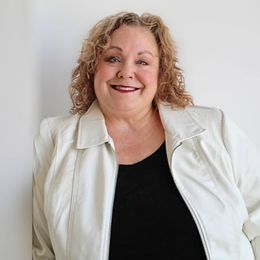How My Healing Journey Changed Completely at 55
Becoming aware about the role of the nervous system and my response to past trauma has helped me move forward with my life
I thought I'd done everything right. Yet here I was, at 55, living in poverty, highly emotional, unable to hold a full-time job, and dependent on the state for groceries and medical care. How could this be my destiny? Was I going to go out like this?

How the Journey Began
In 1996, miserable with every aspect of my life, I found a therapist. On a bus headed to our first meeting, I wrote a monologue in my head – a prepared statement to explain why I was there. A half-hour later, I stepped into her office and blurted, "I think my grandfather molested me."
My memories had no edges. It was like looking at photographs at the bottom of a pool. Occasionally, I'd get a glimpse of something concrete only to have it washed away in a swirl of disbelief.
"I was worthless and unlovable; I couldn't take care of myself; I was only valuable if I sacrificed myself or what mattered to me."
One night, two weeks after I started therapy, I caught a whiff of chlorine walking home from work. Without warning, I began to shake. I couldn't catch my breath. I fell against the wall of a building on the Avenue of the Americas in New York City and pretended to rifle through my briefcase.
I know now that I experienced a panic attack, a Complex Post Traumatic Stress Disorder symptom. I was thirty-three. During those first three years of Cognitive Behavioral Therapy – a modality that focuses on changing beliefs and attitudes, I explored the narratives that created my desire for therapy:
"I was worthless and unlovable; I couldn't take care of myself; I was only valuable if I sacrificed myself or what mattered to me."
One of the biggest challenges during this time was the drive to believe I'd made it all up. Doubt is a common problem for people who were sexually assaulted as children. It's less painful to gaslight yourself than to admit what happened and deal with the fallout.
I spent my days pretending to be strong and my nights smoking pot and inhaling the bounty of food I'd gathered between my office and apartment until I passed out. The following day always brought a violent see-saw of shame and guilt as I threw away empty take-out containers and candy wrappers.
A year later, I found the courage to tell my family. Some believed me. Some didn't. I confronted my grandfather, who told me he didn't remember, but if it had happened, he was sorry. His ambiguity made me unsure. Maybe I was making this up.
I continued unconsciously creating scenarios where I needed to figure out how to escape an impossible situation, repeating this pattern.
Like a lawyer collecting evidence for a trial, I examined every dysfunctional behavior as proof that it had happened. I discussed my findings with the therapist, who never doubted what I said. It took time, but I found a way to believe the evidence.
The Next 20 Years
Two years into therapy, I left my advertising career and six-figure salary to become a writer. I had an agent who loved my first novel and all but guaranteed a book deal. That never happened.
I didn't realize at the time it was one more experience in what I've come to call the Hope/Nope Loop, where I desperately wanted something but could never achieve it. This was seeded in the untenable situation with my grandfather, from which I tried unsuccessfully to escape.
I continued unconsciously creating scenarios where I needed to figure out how to escape an impossible situation, repeating this pattern. Over the next two decades, I filed for bankruptcy twice, bought and lost a house, and was involved in a toxic and abusive relationship with a former felon who stole from me and lied to my boss, which forced me to resign, and was unhoused twice.
This led me to move back to where I grew up, where I took on the mantle of starving artist because I wasn't in a place to admit that the trauma I experienced decades ago was still profoundly affecting my life. It was easier to appear to sacrifice money for my art than to accept that I could not work full-time.
I binged regularly, was utterly disconnected from my body, and couldn't hear anything it tried to communicate until it used a bullhorn — a diabetes diagnosis in 2013.
A Glimmer of Light
I went back to what I knew. Therapy. Over the next five years, I went to two different therapists. I eventually quit them both because I wasn't seeing any tangible progress. I began to believe I was destined to be broken.
Discovering the book "The Body Keeps the Score" by Besser van der Kolk, was my first introduction to understanding that my problems weren't all in my mind. For over twenty years, I ignored the trauma trapped in my body, which was vital to what needed to be healed.
Like a lawyer collecting evidence for a trial, I examined every dysfunctional behavior as proof that it had happened.
I learned that people who experience early trauma often don't feel safe in their bodies. That feeling of safety is required to live a peaceful and productive life. I discovered that focusing on changing thoughts and beliefs doesn't invite you to reconnect with a body abandoned by the mind. What it was saying was too painful to process.
In therapy, the concept of feeling safe was never addressed. I had been so concerned with building security (primarily financial) when what I needed was to feel safe. Acknowledging how these experiences affected my body and how I didn't feel safe was a slow process.
It took several years for me to accept. I was persuaded to believe that it was all in my head. I constantly asked, "what's wrong with me?" rather than, "what is wrong with the system treating me?" I realized that I'd spent most of my life with my nervous system on overload. I was continually in one of the survival modes: fight, flight or freeze.
Choices around food and money and my inability to stand up for myself with clients or in relationships with friends and family reflected how scared I felt. COVID profoundly affected my healing journey because the quarantine and continued isolation were perfect excuses to spend more time on social media.
And once I began to follow content from a couple of progressive therapists who talked about van der Kolk's work and the research of Peter Levine, Stephen Porges, and others whose work discusses the need for the nervous system to feel safe (and what happens when it doesn't) the algorithm gods took care of the rest.
With the help of progressive therapists and trauma coaches across Instagram and TikTok, I learned ways to become more connected to my body. Slowly, my nervous system began to feel safe enough for my subconscious to release information it had withheld out of a desire to protect me.
The little girl I was adored my grandfather and proved unequivocally she was willing to do anything for him. When he ended that part of our relationship, I lost my first love and now had to deal with my broken heart. I began to process the sadness, anger and resentment that lived in my body from the emotions created but unable to be expressed by being forced to be around him, kiss him hello and good-bye, to celebrate holidays together.
It is rarely easy to change. I'm not searching for perfection. Most of the time, I am content with better.
Social media reacquainted me with techniques like EFT Tapping. They introduced me to many other somatic modalities like Havening, grounding and exercises that calmed my nervous system by stimulating the Vagus nerve.
I could now calm myself when I recognized behavior that meant my nervous system had gone into survival mode, which empowered me to regulate my emotions better. This continuing education helped me to connect the dots between feeling unsafe and my behavior. I now knew that wanting to be alone always meant I was in freeze. If I was acting aggressive or angry, I was in a fight. And when I couldn't sit still, I was in flight.
I never imagined what I called habits and eccentricities were trauma responses. This allowed me to examine the people and experiences that triggered my nervous system into these states. At times, the amount of awareness was overwhelming.
It reached new levels as I realized I lived at the intersection of trauma and neuro-divergency, which can include ADD, ADHD, and Autism. Science doesn't fully understand where the demarcation is. I'm not interested in getting an official diagnosis, but what I learned is as debilitating as freeing.
It is rarely easy to change. I'm not searching for perfection. Most of the time, I am content with better. I share real-life examples of what my life looked like before I was conscious about how my nervous system affected my life and how it is now in a series on my Substack called Nervous System: Before & After because I know I'm not the only one who could benefit from this work.
We are all worthy of healing at more profound levels to live our destiny and not our fate.


